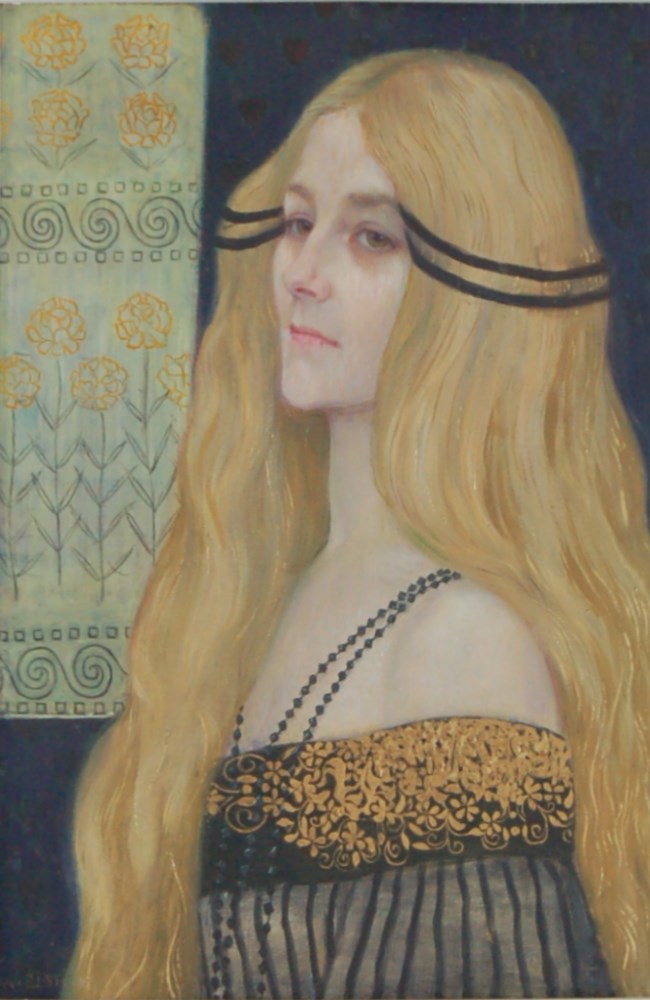Description:
Wilhelm List (1864-1918) was an Austrian painter and graphic artist. He studied at the Vienna Academy, then the Munich Academy and at the Académie Julian in Paris. From 1898 to 1905 he actively participated in the Vienna “Secession”. He belonged to the so-called “Klimt-Gruppe”. He distinguished himself primarily as a portraitist of relatives or friends. The technique in which he created was reminiscent of Aman-Jean’s work. However, the most important part of his artistic activity was woodcuts and lithographs.
Description of the painting:
In the context of French Art Nouveau, Wilhelm List’s “Portrait of a Woman”, a representative of Vienna’s “Secession”, presents a much calmer, less expressive, more subtle, linear, and geometrical view. The ornament becomes an immensely important element in the presentation, complementing it but not dominating it. Although it comes from the natural world, it is not a living organism. It fully submits to the function imposed on it.
The secession period was short. Its beginnings were formed in the 1880s. Around 1890, it seems to have spread independently in many centers—in London and Chicago, Barcelona and Brussels—and with remarkable speed throughout large parts of the planet. The French Art Nouveau was called “Jugendstil” in Germany. In 1897, the creators of the new art dominated the 7th International Art Exhibition in Munich. At the same time, in neighboring Austria, Gustav Klimt and Joseph Maria Olbrich founded the Vienna Secession.
On the exhibition building of the group, the motto “Der Zeit ihre Kunst, der Kunst ihre Freiheit” (“Time is Art, Art is Freedom”) was inscribed in gold letters. The name ‘secession’ itself meant a break, a separation from the prevailing currents and trends in art, from the widely recognized Viennese Künstlerhaus and a turn towards a different trend, a striving for the synthesis of all arts known from the Middle Ages.
In 1903, the architect Josef Hoffmann, together with the graphic artist and painter Koloman Moser, founded the Wiener Werkstätte – the Association of Viennese Craftsmen, which then created its own Wiener Werkstätte Stil – style of Viennese workshops. Representatives of various branches of applied art gathered in it were to create objects of high quality, usefulness and artistic value, satisfying the daily needs of consumers and their aesthetic experiences.
In 1905, the Vienna Secession, due to internal disputes concerning, among other things, the equal treatment of decorative art and traditional fine arts, divided into two groups. One of them gathered around Josef Engelhart, the other was called the Klimt-Gruppe. Members of the latter organized the Kunstschau in Vienna in 1908, during which Klimt’s “Kiss” was presented.
The representative of the Vienna Secession at the Rogalinska Gallery, in addition to the members of the Polish Artists’ Association: Teodor Axentowicz, Julian Fałat, Wlastimil Hofman, Alfons Karpiński, Jacek Malczewski or Józef Mehoffer, is also Wilhelm List.
The artist captured Mrs. Neumann on the portrait – his favorite model. The woman is dressed in a dress that is a realization of the idea of the Wiener Werkstätte. The figure was shown en trois quatre (in three quarters). The light complexion of the model and the delicately flowing on her shoulders strands of wavy golden hair contrast with the dark black-navy background. The way of capturing the silhouette and the composition of the presentation on the one hand lead us to the work of the contemporary artist Gustav Klimt, on the other hand to the stylistics referring to Renaissance portraits.
The artist attached great importance to the elaboration of decorative and ornamental details of the presentation. The gaze focuses on dark headbands adorning the head, two strings of black pearls, striped fabric from which the dress was made and a decorative belt with golden, floral, precisely made embroidery at the level of the exposed shoulders. The element that completes the composition is a fragment of a light green fabric covering the wall, covered with a floral and geometric ornament.


